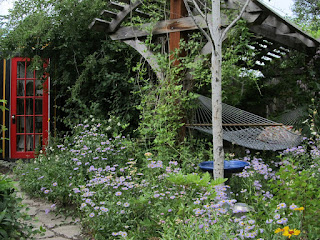Several years ago, our house was on a garden tour sponsored by a local nursery. We were very flattered to be a part of this tour. The organizer of the garden tour and owner of the nursery wrote a description of each garden, including a title and a blurb summarizing the garden and the experience. He called our yard a “Lifestyle Garden”.
I had never heard this term before nor have I seen it since. Initially I was puzzled by the term and thought it was almost an insult or relating to us having an “alternative” lifestyle or something.
However, the more I thought about it, I thought this title was really fitting and since then it has really stuck with me. I was proud of this title, and it seemed like a really unique label for our garden and what we were trying to accomplish. I liked it. I also thought this title must in some way be a reflection of how unique my wife and I are.
But we are not unique, nor anymore unique than anyone else. However, we have done what few others do, that is really personalize our garden by trying something different and something that reflects our interests, beliefs, and yes, our lifestyle.
After some more thinking, I thought that every garden is a "lifestyle garden". But is it? Since that time, I have come to realize that is exactly what is wrong with many gardens and why people want to change them- they didn’t reflect the lifestyles of their owners.
Too often, gardens are a reflection of something or someone else, and some other person’s lifestyle, or an interpretation of what someone’s garden should look like. That is one of the reasons many gardens look the same despite climate differences, regional differences, and certainly the differences in the owners.
Before my wife and I first meet any of our garden coaching clients, we ask them to fill out a survey to help them articulate what their goals are and what they want to do in their garden. Through this process we can begin to understand the clients’, as we say, “wants and needs”, and ultimately help them to create a garden that suits them. In essence, what we try to do is make everyone’s garden their lifestyle garden. I think the best gardens capture someone’s personality and by creating a garden that is a reflection of you and your lifestyle and you will enjoy it, use it more, and feel at home.
I had never heard this term before nor have I seen it since. Initially I was puzzled by the term and thought it was almost an insult or relating to us having an “alternative” lifestyle or something.
However, the more I thought about it, I thought this title was really fitting and since then it has really stuck with me. I was proud of this title, and it seemed like a really unique label for our garden and what we were trying to accomplish. I liked it. I also thought this title must in some way be a reflection of how unique my wife and I are.
But we are not unique, nor anymore unique than anyone else. However, we have done what few others do, that is really personalize our garden by trying something different and something that reflects our interests, beliefs, and yes, our lifestyle.
After some more thinking, I thought that every garden is a "lifestyle garden". But is it? Since that time, I have come to realize that is exactly what is wrong with many gardens and why people want to change them- they didn’t reflect the lifestyles of their owners.
Too often, gardens are a reflection of something or someone else, and some other person’s lifestyle, or an interpretation of what someone’s garden should look like. That is one of the reasons many gardens look the same despite climate differences, regional differences, and certainly the differences in the owners.
Before my wife and I first meet any of our garden coaching clients, we ask them to fill out a survey to help them articulate what their goals are and what they want to do in their garden. Through this process we can begin to understand the clients’, as we say, “wants and needs”, and ultimately help them to create a garden that suits them. In essence, what we try to do is make everyone’s garden their lifestyle garden. I think the best gardens capture someone’s personality and by creating a garden that is a reflection of you and your lifestyle and you will enjoy it, use it more, and feel at home.











































